Photo credit: David Kubovsky on Unsplash
How Much Does it Cost to Live the FIRE Life in Singapore?
Hello, and welcome to interview #20 in the How Much Does it Cost to Live the FIRE Life interview series! Part interview, part spending report, this series will introduce us to FIRE* seekers from all over the world.
They’ll reveal their essential spending and money-saving tips—all to help us learn new ways to save on our own expenses. As a bonus, we’ll also get to discover the unique advantages and challenges of living in different places around the globe.
*FIRE stands for financial independence, retire early. It’s also known as FI—financial independence. For more info, see my FI School series—it’ll teach you everything you need to know about FI (and FIRE).
About the interview series
I created an intro page for this interview series to help explain what it’s about, what’s included (or not) and why. I’ll also link to all the interviews from the intro page—so check back there to see the entire collection.
Jump to the series intro: How Much Does it Cost to Live the FIRE Life? (The Interview Series)
Disclosure: These interviews may include affiliate links. That means I’ll receive a commission if you make a purchase through my links—at no extra cost to you. Thank you!
Interview #20: Hi FI-ing Auntie from Singapore
In today’s interview, we’ll meet Hi FI-ing Auntie, who lives with her partner on the tiny island nation of Singapore. I’d mentioned previously in my interview with Richard (from Side Hustle Rich) that Singapore is the most expensive city and country in the world!
Even so, Hi FI-ing Auntie manages to do quite well with her expenses (which you’ll soon see in her interview).
Note: Hi FI-ing Auntie lives with her partner, but she pays for most of the household expenses. To keep things simple, I’ve categorized her as a single person for the interview.
About Hi FI-ing Auntie (the blog)
Hi FI-ing Auntie is still a very new blog (it only started in February 2021, so go show her some love)! On her blog, Hi FI-ing Auntie shares her FIRE journey, including her investment strategy, how she saves money, and more.
Regarding her unique nom-de-plume, this is what Hi FI-ing Auntie has to say about it:
“For those who are not familiar with ‘Singlish’ (the brand of English spoken in Singapore), an ‘auntie’ is a middle-aged unfashionable woman concerned with value-for-money purchases, gossips, and all sorts of useless facts that may be useful to… someone. In that sense, I’m not really an auntie, but I own the stereotype and proudly call myself one.”
I love the levity and humour that Hi FI-ing Auntie brings to the FIRE community! If you’re looking for a light-hearted take on FIRE, from someone who was not “born to a Crazy Rich Asian family“, you’ll enjoy Hi FI-ing Auntie.
But before you hop over to her blog, have a read of Hi FI-ing Auntie’s interview. You’ll get an insider’s peek into living the FIRE life in luxurious, high-cost Singapore.
Table of Contents
Part 1
Part 2
Part 3
Part 4
Part 1: Getting to know you
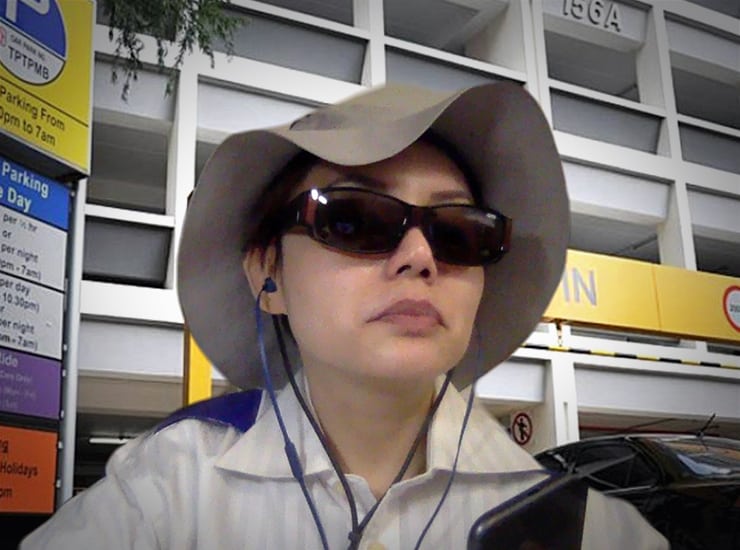
Tell us about yourself
I’m a communications manager in my late 40s. I live with my partner who is an engineer.
We have neither children nor pets.
The expenses listed are my part of the household expenses, plus my personal expenses. That being said, other than utilities, I bear most of the household expenses and my partner and I split our eating-out costs.
Where are you in your journey to FIRE?
It started at around 2018 and I have less than 10 years to go.
What type of FIRE are you aiming for? (FIRE, Lean FIRE, or Fat FIRE*)
How Chrissy defines FIRE, Lean FIRE, and Fat FIRE
Some people define Lean FIRE as under $40k in annual spending; FIRE as $40–$100k in annual spending; and Fat FIRE as $100k+ in annual spending.
However, I prefer looser definitions that are not based on hard numbers. That’s because $100k could be Fat FIRE in a small Canadian town but Lean FIRE in San Francisco. That said, here are my definitions:
- Lean FIRE: The essentials with little or no discretionary spending.
- FIRE: The essentials plus a comfortable amount of discretionary spending.
- Fat FIRE: The essentials plus a luxurious amount of discretionary spending.
I am aiming for FIRE.
Tell us about your living situation
I live in a government-build apartment called an HDB (Housing Development Board) flat in Singapore of around 700 square feet.
I own the apartment.
I have a bus stop three minutes’ walk away and a train station with two lines a 15-minute walk away. I can get to the Central Business District by train in 20 minutes.
Why did you choose to live in Singapore?
I was born here! Singapore is really tiny and it takes only one hour to drive end-to-end 🙂
Part 2: The expenses
In this section, Hi FI-ing Auntie shares her essential expenses and best money-saving tips. But before we get started, let’s review some important notes:
Important notes about the numbers
- Only essential expenses are included.
- Discretionary expenses (e.g. travel, gifts, etc.) are not included.
- Expenses are rounded to the nearest dollar.
- Expenses are displayed in the interviewee’s home currency.
- In this interview, the home currency is Singapore dollars (S$).
- For your convenience, I’ve included a currency converter for each expense.
For detailed explanations about which expenses are included (or not) see my How Much Does it Cost to Live the FIRE Life intro post.
1. How much does housing cost in Singapore?

Mortgage (S$0)
Property is fully paid-off, so NIL. However, before I paid it off, I was paying around S$1,200 per month for a 15-year mortgage.
A unit like mine can be rented for S$1,700 per month.
Property tax (S$20/month; S$240/year)
As it is a government flat, property tax is really low. It’s based on the category of your flat. Ours is considered a three-room flat, so I pay S$18.40 per year.
Strata/HOA fees (S$48/month; S$576/year)
We pay a monthly Service and Conservancy Charge to our town council. For my flat category, I pay S$46 per month. I get regular government rebates on this, so there are months I do not have to pay this charge.
Home insurance (S$0)
I don’t have any—yikes!
Home maintenance (S$100/month; S$1,200/year)
This category includes: home maintenance, repairs, cleaning, and improvements; household goods and supplies; furniture; and appliances.
As it’s an apartment, we don’t have to do much maintenance outside our property. We only take care of what’s inside. So, things like lawn and roof repairs don’t apply to us.
Singapore is really warm but I use ceiling fans and hardly use air-conditioning.
Since my home is so tiny, it’s easy to clean—we use a robot vacuum cleaner that comes with a mop attachment!
My partner is handy with tools, so he handles most of the repairs.
Our appliances have lasted us well so far. My latest purchase was an electric pressure cooker that cost me S$160.
Home equity opportunity cost (S$16,500/year)
About the home equity opportunity cost ‘expense’
This category was suggested by The Economist from FI Garage. The intention for sharing this is to calculate the opportunity cost of home ownership versus renting.
In other words: if you invested the amount that’s tied up in your home equity, how much would that be worth after one year of investing (based on a conservative 5% return)?
Based on the last-done sales transactions, the estimated value of my property is around S$330K. I am sitting on a paper ‘loss’ (I bought the flat for close to S$400K). I do not include this number in my net worth calculations since you can’t eat your house!
S$330,000 x 5% = S$16,500 in opportunity cost after one year of investing.
About my mortgage
Before I paid off my mortgage, I was on a 15-year loan and the monthly mortgage was around S$1,200. I pay the mortgage in cash.
Why this detail is important—we have a compulsory retirement savings scheme in Singapore called the Central Provident Fund which can be used for housing. The CPF balance is ‘locked up’ until age 55 otherwise. Many Singaporeans use the CPF to pay their mortgage. Because it is ‘invisible money’ it does not impact on the monthly budget. I choose not to use the CPF to pay my mortgage.
2. How much does transportation cost in Singapore?

Transit in Singapore
Singapore is a high-density city and very well-connected by public transport. I can walk to the MRT (Mass Rapid Transit or subway) which goes all over the island. There is a bus network that supplements the MRT.
Taxis are cheap compared to the US (maybe Canada too?) and options such as Grab (local version of Uber) make door-to-door transit even cheaper.
My partner rides a motorbike and this is usually how we get around. However, I mostly use the MRT/bus when I go out on my own.
Cars are extremely expensive here. To buy a new car, you need to buy a 10-year permit which currently costs S$40–50,000 (by monthly bidding) and then the cost of the car itself, which is another S$100,000 (1.6L Toyota Corolla Altis). A used Toyota Corolla Altis with 5 years’ permit left costs around S$40,000.
Vehicle loan payments (S$0)
I don’t own a car, so this is S$0.
Vehicle insurance (S$0)
I don’t own a car, so this is also S$0.
Gas (S$0)
I don’t own a car, so this is also S$0.
Vehicle maintenance (S$0)
I don’t own a car, so this is also S$0.
Bike maintenance (S$0)
My partner handles his bike maintenance.
Parking and tolls (S$0)
I don’t own a car, so this is also S$0.
Transit (S$250/month; S$3,000/year)
I travel mostly by bus and train, particularly after work from home started. Occasionally I take a taxi (which is not very expensive) or Grab (local version of Uber).
When we were working out of the office, I would Grab to work everyday. It costs S$20 per trip and takes 25 minutes. By bus and train, it takes 1.5 hours. It’s only because my workplace is located at the far side of the island and not very accessible by train!
3. How much does food cost in Singapore?

Groceries (S$300/month; S$3,600/year)
I usually buy food from the wet market near my home where the vegetables are fresh and imported daily from Malaysia. We eat simply, so I mostly cook one-dish meals. I have a few dishes I usually rotate, so I don’t really have to think too hard about what to cook.
I rely a lot on frozen food like frozen vegetables and meat, canned food like sardines, and bulk foods like pastas. Because I just bought a pressure cooker, I’ve been trying out recipes with cheaper cuts, so hopefully that will cut our eating out budget.
Occasionally, we do splurge on some grocery items like buying expensive Japanese fruits or mangoes from India. Learning to curb that, though!
I’m trying to eat more vegetarian, but my partner loves meat, so he buys the bacon that he adds on everything I cook.
I love cheese, but dairy is expensive here. Sometimes I go slightly deranged and buy lots of cheese and that pushes the grocery bill up.
Related reading: How to Save Money on Groceries (36 Valuable Tips) and Detailed Flashfood Review (Groceries for 50-70% Off)
Eating out (S$400/month; S$4,800/year)
Eating out can be very cheap. I include eating out at restaurants/cafes and lower cost eating out options in Singapore called ‘coffee shop/kopitiam’ and ‘hawker centre’. It is possible to get a meal for S$5 at kopitiams and hawker centres.
At cafes, we tend to choose options that cost S$20–30 per person. Very occasionally, we will visit our favourite restaurants that can cost S$50–70 per person. We don’t drink alcohol, so that keeps the bills lower (alcohol is very expensive in Singapore).
My partner and I split the cost of eating out and the figure shows my part of the expenditure.
I’ve been trying to reduce the frequency of ordering in food, and cook more. You tend to over-order so as to get free delivery and that really bumps up our food bills!
Here’s an example of what you can get at kopitiams or hawker centres (lor mee or yellow noodles with gravy):
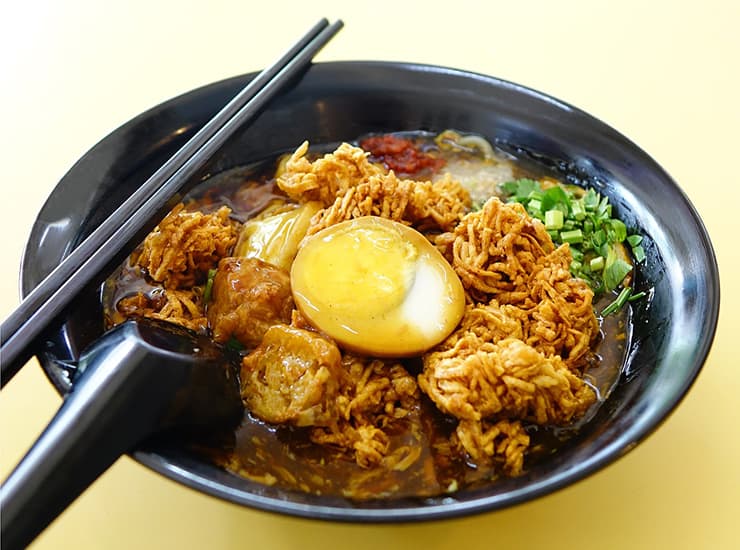
Here’s a kopitiam at Geylang:
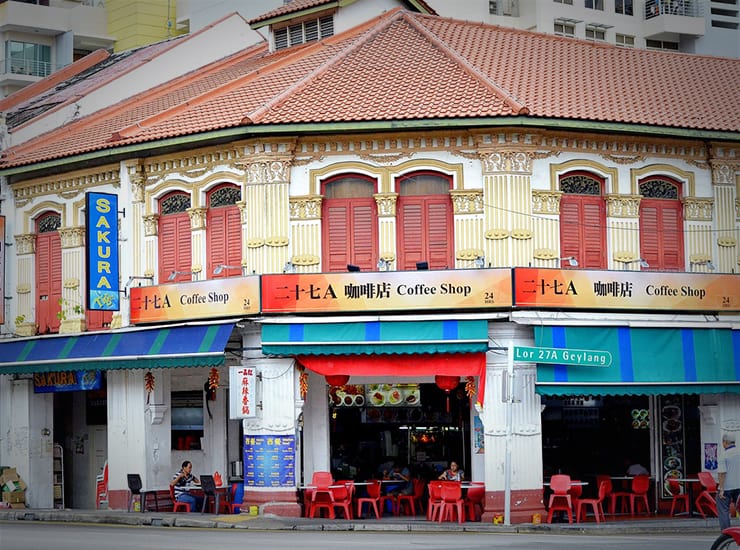
4. How much do utilities and bills cost in Singapore?
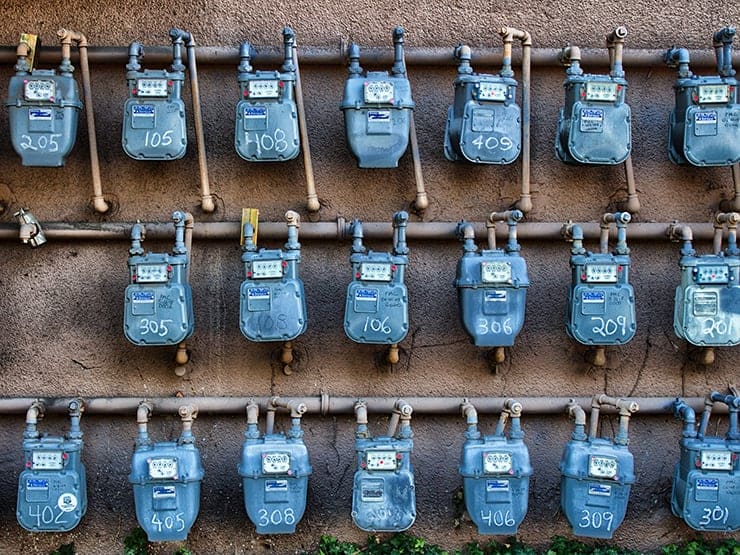
Gas, electricity, water, and garbage are borne by my partner, but I included them here. We get regular rebates, so there are months where this does not have to be paid.
Natural gas (S$20/month; S$240/year)
Gas is used for cooking, not heating. We have a single supplier, so no choice here.
Electricity (S$20/month; S$240/year)
Many Singapore households have air-conditioning, which uses a lot of electricity. We seldom turn ours on and instead rely on ceiling fans. We can choose our retailer and we have a fixed price package with Tuas, which is about 30% cheaper than government rates.
Water (S$20/month; S$240/year)
National water supplier, so no choice here either. This includes cost of water, water conservation tax (a premium to encourage water conservation), and sanitary appliance fee and waterborne fee (cost of treating sewage).
Garbage and recycling (S$20/month; S$240/year)
We have a rubbish chute in our flat through which we can dispose of our rubbish. There isn’t recycling done by the garbage provider—we have to take our recyclables to special bins around the estate. However, most people just throw them down the chute!
Internet (S$40/month; S$480/year)
My partner pays this as he’s a gamer. We use MyRepublic.
Home phone (S$0)
We don’t have one.
Cell phones (S$30/month; S$360/year)
Around S$30 for 24GB data, unlimited incoming calls, 100 minutes outgoing calls, and 50 SMSs (texts) with Circles.Life. You can get 50GB for S$20 with Gomo. I may switch soon.
Streaming entertainment (S$0)
We watch YouTube!
5. How much do other essentials cost in Singapore?

Life and disability insurance (S$190/month; S$2,280/year)
This is for income disability insurance (with Aviva) in case I become disabled during my employment. Because I am female, the premium is extremely high.
Healthcare in Singapore
Singapore has a dual-tier healthcare financing system. We have a subsidised system that all citizens are entitled to. Cost of healthcare under this system is very high quality and relatively cheap—you can see a GP for less than S$20.
Some parts of the expenses can be deducted from Medisave (part of CPF) which is a compulsory savings scheme. This means out-of-pocket expenses can be reduced further.
We have a national hospitalisation and surgical insurance called Medishield Life that takes care of MOST expenses and categories, and it has a co-payment and excess element. However, this system is overused and can be very time-consuming and have long waiting times.
We can go private (without need for referrals) but the costs are all out-of-pocket. It is possible to buy insurance to meet these out-of-pocket expenses but they are very expensive.
Most who are in full-time employment get some form of medical benefits that help defray medical costs.
Medical insurance (S$120/month; S$1,440/year)
This is the cost of my insurance rider with NTUC Income (an insurance provider in Singapore) to bear the co-payment and excess part of Medishield Life. As the premiums for Medishield are deducted from our CPF* I did not include this in our monthly budget.
*The CPF is a compulsory retirement savings scheme in Singapore called the Central Provident Fund.
Out-of-pocket medical expenses (S$400/month; S$4,800/year)
I see private specialists regularly and these are the direct payments made to them for consultation and medication.
Clothing and footwear (S$150/month; S$1,800/year)
I wear my clothes to death and I am still wearing clothes that are 5 years old. I wear the same thing every week. However, I do buy specific items now and then.
I replace my footwear once a year (that has changed with Covid though!)
Personal care (S$300/month; S$3,600/year)
This category includes: haircuts, toiletries and grooming services and supplies.
Supplies are included in groceries. I get my hair done every three months but I try to stretch it out, ha ha ha.
Technology (S$100/month; S$1,200/year)
This category includes essential technology: software and hardware purchases, upgrades, maintenance, and repairs. Non-essentials (video games and consoles, e-readers, security cameras, etc.) aren’t included.
I subscribe to an Adobe package which is extremely expensive. If anyone has good alternatives for Premiere Pro and Premiere Rush, please let me know!
I use my Samsung phone till it dies so I replace it usually once every 4 years.
Part 3: Adding it all up
Now that we’ve detailed all of Hi FI-ing Auntie’s essential expenses, it’s time to add everything up in some nice, organized tables!
Important notes about the numbers
- Only essential expenses are included.
- Discretionary expenses (e.g. travel, gifts, etc.) are not included.
- Expenses are rounded to the nearest dollar.
- Expenses are displayed in the interviewee’s home currency.
- In this interview, the home currency is Singapore dollars (S$).
- For your convenience, I’ve included a currency converter in each section. I hope you find it useful!
For detailed explanations about which expenses are included (or not) see my How Much Does it Cost to Live the FIRE Life intro post.
How much does it cost to live the FIRE life in Singapore?
1. Housing
| Expense | Monthly (SGD) | Annual (SGD) |
|---|---|---|
| Mortgage | $0 | $0 |
| Property tax | $20 | $240 |
| Strata/HOA fees | $48 | $576 |
| Home insurance | $0 | $0 |
| Maintenance | $100 | $1,200 |
| TOTAL | $168 | $2,016 |
Home equity opportunity cost: $16,500/year
2. Transportation
| Expense | Monthly (SGD) | Annual (SGD) |
|---|---|---|
| Vehicle loan | $0 | $0 |
| Vehicle insurance | $0 | $0 |
| Gas | $0 | $0 |
| Vehicle maintenance | $0 | $0 |
| Bike maintenance | $0 | $0 |
| Parking and tolls | $0 | $0 |
| Transit | $250 | $3,000 |
| TOTAL | $250 | $3,000 |
3. Food
| Expense | Monthly (SGD) | Annual (SGD) |
|---|---|---|
| Groceries | $300 | $3,600 |
| Eating out | $400 | $4,800 |
| TOTAL | $700 | $8,400 |
4. Utilities and bills
| Expense | Monthly (SGD) | Annual (SGD) |
|---|---|---|
| Natural gas | $20 | $240 |
| Electricity | $20 | $240 |
| Water | $20 | $240 |
| Garbage and recycling | $20 | $240 |
| Internet | $40 | $480 |
| Home phone | $0 | $0 |
| Cell phones | $30 | $360 |
| Streaming entertainment | $0 | $0 |
| TOTAL | $150 | $1,800 |
5. Other essentials
| Expense | Monthly (SGD) | Annual (SGD) |
|---|---|---|
| Life and disability insurance | $190 | $2,280 |
| Medical insurance | $120 | $1,440 |
| Out-of-pocket medical expenses | $400 | $4,800 |
| Clothing and footwear | $150 | $1,800 |
| Personal care | $300 | $3,600 |
| Technology | $100 | $1,200 |
| TOTAL | $1,260 | $15,120 |
Grand totals
| Expense | Monthly (SGD) | Annual (SGD) |
|---|---|---|
| Housing | $168 | $2,016 |
| Transportation | $250 | $3,000 |
| Food | $700 | $8,400 |
| Utilities and bills | $150 | $1,800 |
| Other essentials | $1,260 | $15,120 |
| TOTAL | $2,528 | $30,336 |
Part 4: Other expenses
This is a special section that’s just for fun! It’s the place for my interviewees to mention any expenses that they’ve done a really good job of optimizing and/or just want to share.
These expenses won’t be included in the totals (just to keep things as standardized as possible). I hope you find this section interesting and informative. Here’s an additional expense that Hi FI-ing Auntie wanted to share:
Gym (S$200/month)
I work out with a strength and conditioning gym and I consider that essential for my health and well-being! It costs me about S$200 per month. I share the package with a friend.
That being said, there are also free health classes we can go to online or in person all over the island. I’ve been using these free resources to supplement my workout.
Hi FI-ing Auntie’s closing thoughts
We’re a two-person household, but I’ve shared only my own part of the expenditure, unless otherwise indicated in the worksheet. However, as I bear most of the expenditure, I think it’s quite indicative of how much a single person needs to live in Singapore.
We’re also generally frugal. We tend to travel within Asia and regularly to Malaysia where the cost of living is much lower.
Chrissy’s takeaways
Thank you to Hi FI-ing Auntie for sharing her expenses! As always, I enjoy learning about the cost of living in different locales around the world. It’s especially interesting and inspiring to read about people like Hi FI-ing Auntie, who are aiming for FIRE in extremely HCOL cities like Singapore.
Here are my takeaways from Hi FI-ing Auntie’s interview:
Getting more accurate
Hi FI-ing Auntie lives with her partner, Mr. Auntie, but pays for most of their household expenses. However, Mr. Auntie pays for the utilities and also pays her some rent. Given this, the expenses she’s shared here are actually higher than what they should be.
If she were to split the housing costs (S$2,016), utilities (S$1,440/year), and groceries (S$3,600/year) that would bring her annual cost down by S$3,528. So her annual total of S$30,336 would actually be S$26,808 ($24,661 CAD or $19,890 USD).
That’s very good—especially considering how expensive Singapore is.
Public transit for the win
While Hi FI-ing Auntie’s public transit costs (S$250 per month) are about the same as what we’d pay to insure, maintain and fuel a car in North America, it’s actually the more affordable option in Singapore.
As she mentions in her interview, the cost to purchase and own a car (even an economical one) is simply outrageous in Singapore. Good job, Hi FI-ing Auntie, for making the frugal (and eco-friendly) decision to forgo a car and take transit instead!
Groceries versus eating out
I believe Hi FI-ing Auntie pays for all the groceries for her and Mr. Auntie. Given this, her S$300 per month grocery bill is actually S$150 per month ($138 CAD or $112 USD) for her portion. This is very reasonable—especially since Singapore imports 90% of its food (which results in higher prices).
However, Hi FI-ing Auntie’s eating out costs are another story! Her S$400 per month is quite high…but I approve and totally get it. (Have you seen Street Food: Asia? There’s so much yumminess to be enjoyed in Singapore! 😋)
If I lived there, I’m 1,000% sure my eating out costs would be even higher than hers! But, as I’ve mentioned many times previously, it’s important to enjoy some of your money on your FIRE journey. There’s nothing wrong with not optimizing every last expense.
So, go ahead, Hi FI-ing Auntie—enjoy those yummy lor mee noodles at the hawker centre. (Maybe one day, I’ll visit and enjoy a bowl with you!)
Disability insurance and healthcare
Hi FI-ing Auntie’s largest expense category is “Other Essentials“. This category includes her disability insurance and healthcare costs, which are quite costly. These items total S$8,520 per year ($7,825 CAD or $6,337 USD).
Thankfully, she’ll be able to drop the disability insurance (S$2,280 per year) once she reaches FIRE. However, the healthcare costs (S$6,240) will remain. That’s not cheap! I hope that in retirement, government benefits might kick in to help with some of the costs.
Chrissy’s closing thoughts
I love that Hi FI-ing Auntie’s not afraid to be frugal (she wears her clothes “to death” and uses the same phone for four years). This is not easy in Asian countries like Singapore, where you’re surrounded by extreme wealth.
There’s a lot of societal pressure to ‘keep up with the Joneses’—including wearing all the latest fashions and keeping up with the latest tech. Something as minor as not carrying around the ‘right’ high-end handbag can set you back at work or turn you into a social outcast.
We think consumerism is excessive here in North America, but it’s on a whole other level in Asia. This is why I think it’s extra-amazing to meet Hi FI-ing Auntie and anyone who’s pursuing FIRE in an expensive Asian city.
Kudos to you, Hi FI-ing Auntie, for persevering with FIRE, despite the societal and cultural headwinds! Thanks also for being so open and sharing your expenses here. You’ve shown that it’s possible to buck cultural norms and find financial success—even in the priciest city in the world.
More insight from Hi FI-ing Auntie
After I published the interview, Hi FI-ing Auntie was kind enough to write a post about her interview with me! In her post, she provided additional insight into her spending and how much things really cost in Singapore.
You can check out her post here: Auntie is Featured on Eat Sleep Breathe FI! Thanks again for joining me in this interview, Hi FI-ing Auntie!
Connect with Hi FI-ing Auntie
If you’d like to learn more about Hi FI-ing Auntie or read more of her content, visit her at her blog, Hi FI-ing Auntie. You can also connect with her on Twitter.
Share your thoughts
Were you surprised by Hi FI-ing Auntie’s essential expenses? Are any of them significantly different from where you live? Share your thoughts in the comments, along with your own money saving tips!
Pittsburgh, PA probably doesn’t come to mind when thinking of FIRE-friendly places to live. But you may just rethink that after reading about Vi and her husband’s low expenses!
Visit the intro page to learn more about the what and why behind the series and access the complete list of interviews.
Support this blog
If you liked this article and want more content like this, please support this blog by sharing it! Not only does it help spread the FIRE, but it lets me know what content you find most useful. (Which encourages me to write more of it!)
You can also support this blog by visiting my recommendations page and purchasing through the links. Note that not every link is an affiliate link—some are just favourite products and services that I want to share. 🙂
As always, however you show your support for this blog—THANK YOU!

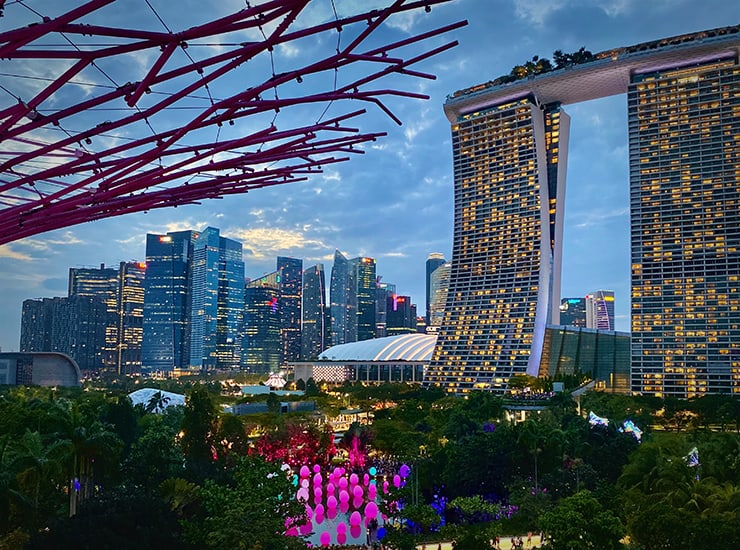





19 Comments
Al Wadd
August 4, 2021 at 8:02 amWonderful, it’s amazing to see that it is possible to live on such a small amount in such a high COL area!
It would be interesting to see whether this low level of expenditure can be maintained as the kids get older and perhaps ‘need’ activities such as sports clubs, music and swimming lessons not to mention constantly outgrowing their clothes and uniforms. Also no costs are mentioned for your live-in helper – I know they are very popular in HK and Taiwan too. Are you able to provide some indicative costs?
Chrissy
August 4, 2021 at 10:04 amHi Al—thanks for reading and commenting. Kids’ activities aren’t included in the series as many interviewees don’t have this expense. (I’m trying to keep the expenses as consistent as possible, so discretionary spending like this is omitted!)
However, I would be curious to learn about about Richard’s current cost for this as well as for his live-in helper. I’ll ping him to see if he’s able to share this info!
Chrissy
August 4, 2021 at 3:14 pmHi again Al—Richard sent me more info on their live-in helper and kids’ activities. I’ve added it to the “Other expenses” section!
GYM
August 4, 2021 at 1:20 pmGreat interview!! How much per month is the in home helper? I know it’s not “essential” but it is part of living for a lot of people in Singapore I think?
Interesting that property taxes are so low! And just tax in general eg no capital gains tax or taxes on your investments. I wasn’t sure I read it but isn’t there also a health insurance tax taken from your income to pay for your future health care needs?
Chrissy
August 4, 2021 at 3:19 pmHi GYM—you’re right that a live-in helper is a part of living for many in Singapore and other Asian countries. I just added this expense to the “Other expenses” section. Richard said they pay their helper $650 per month plus food and toiletries.
It’s crazy to me how low the property and income taxes are. Doesn’t seem to add up for the amazing infrastructure they have, but that is indeed the case. Yes, Richard did mention that there’s a mandatory contribution to a medical fund called Medisave.
I find it so interesting to learn about taxes, healthcare, etc. in other countries!
Dave
August 20, 2021 at 1:40 pmSo pre-school costs per child are S$1600/month but the live in domestic helper is S$650/month.
Does no one see something wrong with this picture? It just seems to me that slavery is very much alive and well. I don’t care that the helper is from the Philippines and wages are lower there. It’s still treating people like 2nd or 3rd class individuals. It just makes me feel sad that the human condition is not actually improving. I can’t say It’s much better here in Canada when you consider domestic workers or agricultural workers who are imported from 2nd and 3rd world countries to do the work no one else is willing to do.
Chrissy
August 20, 2021 at 4:06 pmHi Dave—your comment and observations are absolutely valid. My reply to you is below. (Note that I pass no judgement on Richard. My thoughts on this issue come from a societal, not individual viewpoint.)
It’s heartbreaking that so many domestic helpers leave their own children and families behind in order to care for those of others. They do this because they have little to no options in their homelands. This is one of the few ways they can attempt to give future generations a better life.
On one hand, it’s certainly possible for foreign domestic workers to get ahead (I’ve seen it many times first-hand). Working abroad can be a way out of extreme poverty not just for them but their families as well. On the other hand, poor working conditions and abuse of these workers is rampant and yes, can be very much like slavery.
There’s no easy way to reconcile this problem. Government oversight can help, but isn’t enough. As individuals, we can help by speaking up and supporting the rights of these workers. And if we ourselves are in need of their help, we must pay a fair wage and treat these people as equals, not as 2nd or 3rd class individuals.
I myself have hired a few Philippino nannies over the years to help me with house cleaning (they do it on the side to supplement their regular nanny jobs). I paid them well over the going rate, treated them as part of the family, and helped them find new employment when they needed it. I have seen these hard-working nannies save up enough to bring their families over, buy property in Canada and their homelands, and become financially successful.
Of note, the nannies I’ve known have told me that working conditions and wages in Asia tend to be lower than in Canada. Most of them start off working for families in Asia, but try as quickly as possible to apply to work in the US or Canada. Wage disparity and unsatisfactory working conditions do seem to be bigger issues in Asia than here in Canada.
This doesn’t absolve Canada of its poor record when it comes to fair treatment of foreign workers, but it does show it is possible to do better. And that we all need to keep pushing for better, no matter where we live.
I appreciate that you brought up this important topic. It’s not an easy one to navigate, but talking about it openly at least brings it into the open. That’s a good first step.
Teresa
August 23, 2021 at 4:49 pmIt is so very interesting to read about about how much it costs to live in Singapore because I grew up in HongKong but became a proud Canadian when we came here in 1968! I had no idea what it would cost to live in Asia. Chrissy is right about nannies that get their training in Asia and then get the opportunity to come to Canada and work here, save up, bring their families over and buy a home. The caregiver I have employed for the past 5 years to take care of my 95 year old mother told me when she was new that what I paid her in 4 days was equivalent to a whole month’s salary in Singapore. We pay all her food and give her a private room with full ensuite. In the 5 years she has worked for us, she has saved $100,000 and will be bringing her husband, son and twin daughters here in a couple of months. We treat her like family and even after my mother passes, we will continue to help her settle with her family and anything they may need. I feel the nannies and caregivers are essential help for our young children so parents can go to work and for elderly folks to be able to remain in their homes. It certainly is not slave labour here.
Chrissy
August 24, 2021 at 4:43 pmHi Mom—it’s eye-opening to learn the difference in pay between Singapore and Canada. Wow, that’s huge. Thanks for sharing this info. I know you treat your mom’s caregiver very well, and I have no doubt that she will remain a part of our family even when she’s no longer caring for grandma. I just wish all foreign workers were treated as well as you’ve treated her.
Mr. Dreamer
October 27, 2021 at 8:34 amThanks for another Cost to live post, Chrissy.
I don’t understand why they say Singapore is very expensive? All the mentioned numbers seem lower than what it costs in Canada (Except car ownership).
Giving us the real perspective of the cost in a country is really helpful. Thanks.
Chrissy
October 27, 2021 at 3:58 pmHi Mr. Dreamer—thanks for reading and commenting! I think Hi FI-ing Auntie replied to this on Twitter. It sounds like, as with living in Vancouver, the headlines represent the average spender and not a frugal FIRE seeker!
One of the biggest lessons from this interview series is how it’s very much possible to live a comfortable life AND save a lot of money, even if you live in an HCOL area. Conversely, LCOL areas do not automatically translate to lower essential spending.
I never would have guessed this until I started this series. It’s been eye-opening!
Teresa
November 2, 2021 at 4:15 pmI always thought living in Singapore would be over the moon expensive but as Chrissy says, most of her expenses are lower than what we pay in Vancouver. I would love to have good transit in Vancouver like we have experienced travelling in many other countries because I would love to give up driving. The biggest attraction for my hubby is the hawker centers in SE Asia so once it is safe to travel, we will be visiting for sure! I am really curious about what the HDB (Housing Development Board) is. Do they build affordable housing so people can afford to own their home? I would love to see that happen here in Canada! How do you qualify? How does that compare to regular housing in Singapore? Finally I think Hi-FI-ing auntie deserves kudos for not wasting money on the latest fashion in a place where such things count!
Chrissy
November 2, 2021 at 8:42 pmHi Mom—it has been very surprising to learn that HCOL places can actually be quite affordable. (But you must be willing and know how to live frugally, as Hi FI-ing Auntie does!)
Regarding the HBD housing, Richard (a previous interviewee, also from Singapore) says this in his interview:
“Singapore rarely has any land that is freehold. 80% of us live on ‘government-subsidized’ housing, or public housing flats. Even though we’re labeled owners of the apartment, in actual fact, these flats are sold to you on a 99-year lease, after which the government has an option to take it back without any compensation.”
It’s an interesting system with pros and cons, I’m sure. I wonder if government-subsidized housing would help affordability in Vancouver?
Yes, I agree that Hi FI-ing Auntie deserves kudos for doing her own thing, despite the societal pressure to be spendy and showy with your wealth!
Teresa
November 3, 2021 at 9:45 amThanks for reminding me about Richard’s explanation of HBD housing. I guess it is similar to 99-year leasehold properties in Vancouver. It is a tough concept for most Canadians including me (I seldom sold leasehold properties as a realtor) but in time, if it means affordability, it may become more accepted. Leasehold ownership has evolved over the past 20 years and that is good for the younger generation to have the security of owning their own home if they wish to.
Chrissy
November 3, 2021 at 7:53 pmHi Mom—yes, HBD housing is similar to leasehold properties in Vancouver… except there are no government subsidies! That is an added bonus in Singapore.
As real estate becomes more and more unaffordable here, Vancouver may need to start considering ideas like this. It’ll be interesting to see how things evolve in the coming decades.
David @ Filled With Money
November 9, 2021 at 6:03 pmI like the series that has international experiences because it shows the expenses from other countries around the world. This was a great breakdown. I was. a little shocked that the expenses are comparable to what I’m paying currently in the United States.
Eye opening.
Chrissy
November 9, 2021 at 8:42 pmHi David—isn’t it fun seeing expenses in other countries? I’ve loved being able to take a peek at life and spending all over the world! It was totally surprising to see that Singapore is more affordable than most would think. Thanks so much for reading and commenting!
Angie
March 28, 2022 at 6:30 amLooking at her expenses, I feel like I’d spend about 35000 SGD, or about $26K USD spot annually.
This isn’t super unreasonable I think. And it’s quite attractive because I think English is the primary language of Singapore, and also things like crypto aren’t taxed there. Also, the food is supposedly pretty good. My main concern is the immense healthcare costs (and I thought the costs here in the States were expensive)!
Though it seems like a $1700/mo SGD apartment and other COL items would more than offset the costly medical expenses. Was wondering if there was a good way to be both a US citizen while working in another country like Singapore as an ex-pat to maximize tax benefits while minimizing healthcare costs.
Chrissy
April 1, 2022 at 8:13 pmHi Angie—I agree that Singapore is attractive. It’s much cheaper to live there than I’d assumed! Yes, to the yummy food, LOL. (Have you seen “Street Food: Asia” or “Somebody Feed Phil”? Those shows may convince you to move to, or at least visit Singapore. Sooo much delicious food there.)
Regarding the healthcare costs, I believe those may be an anomaly in High FIing Auntie’s situation. Check out Richard’s interview—he lives with his wife and two kids in Singapore, and their healthcare costs are very low. Living as an expat in Singapore would be really cool. It’s definitely worth looking into!